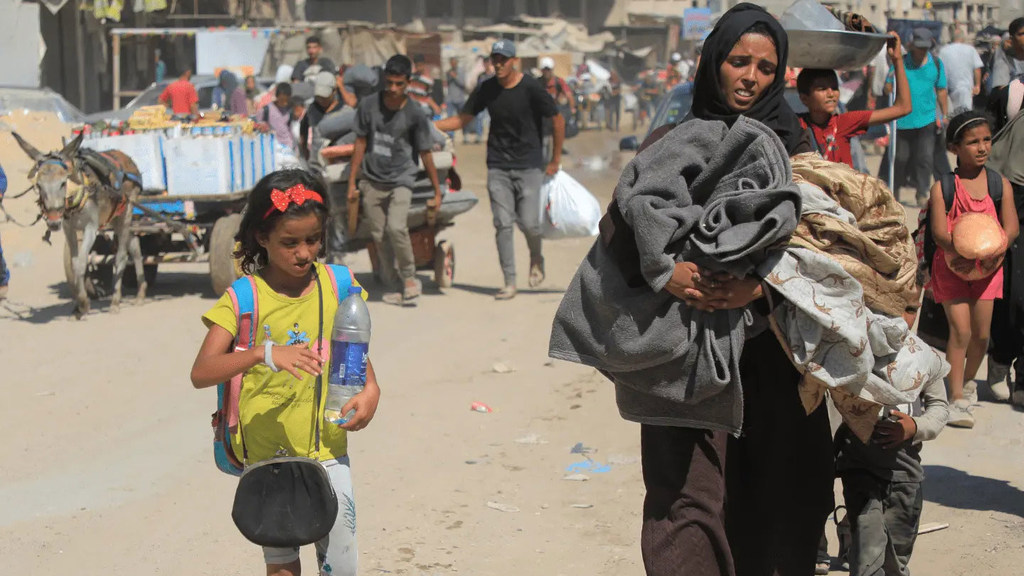Breadcrumb

Gaza: Aid trucks still waiting for Israeli green light inside enclave

Existing supplies of basic necessities have been running dangerously low and on Wednesday the UN Children’s Fund, UNICEF, said that its nutrition stocks to prevent increasing malnutrition “are almost gone”.
“Humanitarian assistance is being weaponised to serve and support political and military objectives,” said Philippe Lazzarini, head of the UN agency for Palestinian refugees, UNRWA.
Speaking at the European Humanitarian Forum, Mr. Lazzarini insisted that significant stocks of aid remain blocked at the enclave’s borders.
“UNRWA is a lifeline for people in face of immense needs,” he said, noting that the whole humanitarian community in Gaza remains ready to scale up the delivery of critical supplies and services.
The development comes a day after UN humanitarians said that they had been allowed to send “around 100” more aid trucks loaded with supplies into Gaza. It is understood that several dozen additional trucks entered the enclave on Tuesday at Kerem Shalom where they await further Israeli permissions before the aid they are carrying can move further into Gaza.
Too little, too late
While such a move would be welcome in light of the desperate humanitarian emergency created by Israel’s total blockade, relief teams have pointed out that this would be a fraction of the 500 trucks that entered the enclave every day before the war erupted in Gaza in October 2023.
Today, one in five Gazans faces starvation, according to respected food security experts from the UN-backed Integrated Food Security Phase Classification platform – or IPC.
UN agencies have repeatedly stressed that they have stockpiles of relief supplies ready to enter Gaza.
After 80 days of total blockade of humanitarian assistance, families in Palestine have been pushed to the brink of starvation, the UN World Food Programme (WFP) warned on Wednesday.
Conditions on the ground are horrific and putting more than two million lives at risk, it insisted, while more than 130,000 tonnes of food wait at border crossings.
“WFP is doing everything possible to get the necessary permissions and clearances to bring in at least 100 trucks a day with emergency food and other aid in the coming days,” said Antoine Renard, Country Director WFP Palestine. “This can only happen if we have immediate access and safe delivery guaranteed.
But he warned that even 100 trucks a day would only meet “the very minimum” of people’s food needs for the month: “On the ground, the situation is growing more desperate and the risk of insecurity and looting of human goods becomes even greater, as we speak a bag of wheat flour costs $500 in Gaza.”
Economic ‘paralysis’
Across Gaza, the daily struggle to find food and water continues because of the Israeli blockade of all commercial and humanitarian access.
Markets are “severely paralyzed”, supply chains have collapsed and prices have spiked, WFP said.
“The population is now facing extreme levels of poor dietary diversity, with most people unable to access even the most basic food groups,” the UN agency warned in its latest update on Gaza.
“Several essential food items, including eggs and frozen meat, have disappeared from the market,” it said. “Wheat flour has reached exorbitant prices, with increases of over 3,000 per cent compared to pre-conflict levels and more than 4,000 per cent” compared to the ceasefire period from January to March.
While the Gazan economy is now in “near-total paralysis”, the West Bank is also staring down a deep recession, with combined overall output shrunk by 27 per cent.
Given that this is the deepest contraction in the Occupied Palestinian Territory in over a generation, WFP cited projections that Gaza will require 13 years to recover to pre-crisis levels and the West Bank three years.
Occupied West Bank demolitions continue
In the occupied West Bank, meanwhile, demolitions of Palestinian property have continued on a daily basis, the UN human rights office, OHCHR, said on Wednesday.
It reported new destruction of a park, a public hall and a swimming pool earlier this week in Beit Sahur, Shu'fat and Nahhalin.
“This is an area that the settlers have been seeing and observing for a while to take over,” said OHCHR head of office in the Occupied Palestinian Territories, Ajith Sunghay.
He explained that Palestinian properties are demolished every day on the grounds that they do not have Israeli building permits – even though these are next to impossible for Palestinians to obtain.
Every day, meanwhile, Israeli settlers install “new outposts which encroach on Palestinian lands…as a calculated tactic to displace Palestinians and consolidate the annexation of West Bank”, Mr. Sunghay told UN News.
"There is an international Court of Justice advisory opinion, which asks the Israelis to end the occupation of the Occupied Palestinian Territory as soon as possible…The harm that it causes to the Palestinians on their daily lives, on their family’s lives, on their rights is immeasurable and this is happening by the hour.”
According to the UN aid coordination office, OCHA, Israeli settlers have damaged water infrastructure in the West Bank more than 60 times since the start of the year. Herding communities have been impacted most severely.
